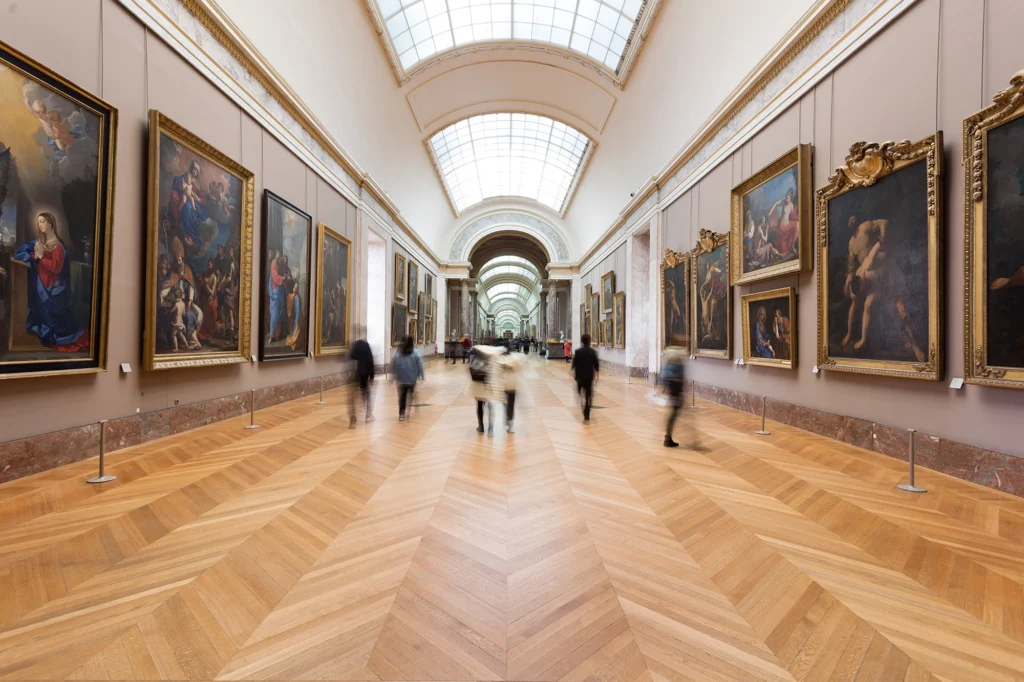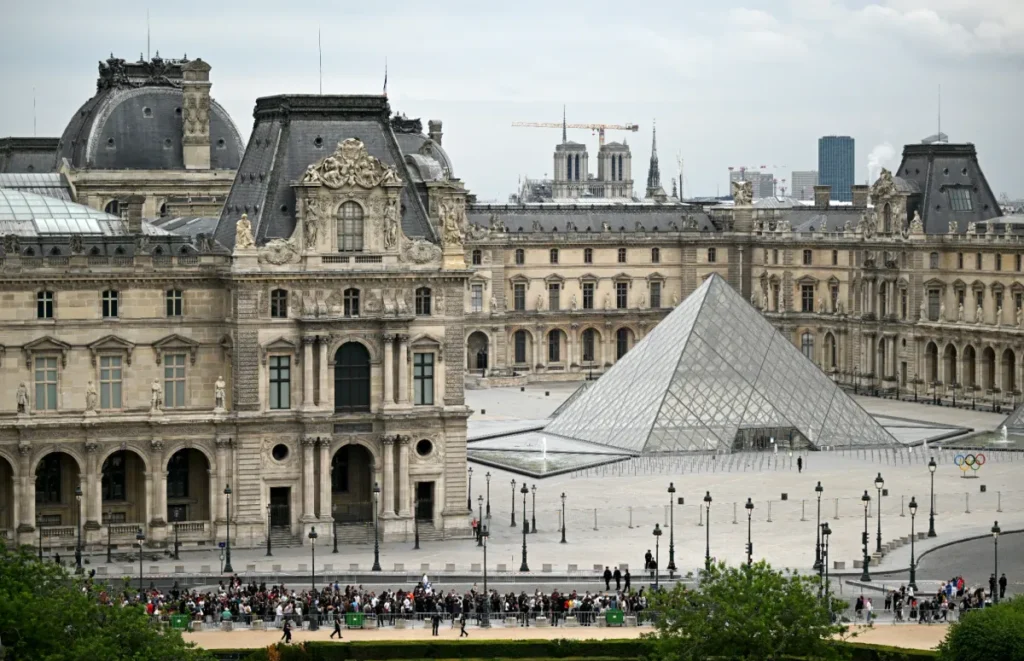On October 19, 2025, the world’s most visited museum, the Louvre in Paris, was rocked by a daring theft. In broad daylight, professional criminals struck within minutes, breaching high security to steal priceless jewels from France’s royal and imperial collections. The museum was evacuated, closed for the day, and investigators have launched a massive inquiry. This extraordinary event has stunned the art world, raised serious security questions, and revived memories of past museum heists. In this article, we compile everything currently known, analyze the significance, and discuss the potential fallout.

Timeline & Known Facts of the Heist
The Heist in Detail
- At roughly 9:30 a.m. local time (CET), the robbers struck, just after the museum’s morning opening.
- The thieves gained access via a window in the Galerie d’Apollon (Apollo Gallery), which houses France’s crown jewels and various imperial regalia.
- They used heavy cutting tools (such as an angle grinder or disc cutter) to break through glass and access display cases.
- Authorities say the operation was extremely quick — the entire robbery took only seven minutes.
- The thieves fled on motorcycles / scooters, escaping before law enforcement could react.
- No injuries were reported among staff or visitors.
- remainder of the day to preserve the crime scene and allow investigation.
What Was Stolen (And What Might Be)
- The stolen items are described by officials as “priceless” with inestimable heritage value — rather than simply market value.
- Early press reports suggest nine pieces were taken, likely from the Napoleon and Empress Joséphine collection (e.g. tiaras, brooches, diadems)
- One piece—possibly the Empress’s crown or a diadem—was later recovered damaged just outside the museum.
- Because the official inventory is still being drawn up and sealed, authorities have not publicly confirmed every missing object.

Entry Method & Tools
- The robbers are said to have used a basket lift / cherry picker mounted on a truck to reach an external façade area under construction, from which they broke the window.
- They also reportedly used a goods lift / freight elevator to reach the targeted gallery space.
- Cutting implements (angle grinders, disc cutters) enabled the criminals to breach display glass and extract jewels.
Security Response & Investigation
- French Interior Minister Laurent Nuñez has described the robbery as extremely well organized by experienced criminals.
- Investigators are analyzing surveillance footage, forensic evidence, and escape routes.
- The Paris public prosecutor’s office has opened an inquiry into organized theft and criminal conspiracy.
- Museums and cultural institutions across France are reportedly being placed on heightened alert. (Implied in coverage)
- The Louvre’s administration is cooperating with investigators, and the incident raises pressure for a review of museum security protocols.
Historical Context: Why This Heist Is So Shocking
The Louvre’s Prestige & Collections
- The Louvre is not just a tourist magnet; it is a repository of human history and art, with thousands of objects, from prehistoric artifacts to Renaissance masterpieces and imperial regalia.
- The Galerie d’Apollon is a special gallery dedicated to French crown jewels, diadems, and precious regalia — objects of both artistic and symbolic national importance.
- Over recent years, the museum has faced challenges: overcrowding, aging infrastructure, strain on conservation, and critique from staff and unions about working conditions.
- In January 2025, President Emmanuel Macron announced plans for a significant renovation and expansion of the museum, partly to address capacity and structural weaknesses.
Past Thefts & Heists at the Louvre
- The 1911 theft of the Mona Lisa remains one of the most famous museum heists. Vincenzo Peruggia, an Italian handyman working at the Louvre, stole it disguised as a worker. It was recovered two years later.
- After that, the museum has had sporadic episodes of attempted damage, vandalism, or smaller thefts, but rarely a high-profile raid of this magnitude.
- Because of the rarity of such large-scale thefts inside the museum vaults, this 2025 heist will almost certainly become part of the museum’s lore.
Significance & Implications
Cultural & Symbolic Impact
- The stolen jewels are not just valuable in monetary terms: they are national heritage, symbolically tied to France’s monarchy, empire, and identity. Their loss or damage is a blow to cultural memory.
- The fact that the heist targeted royal and imperial jewelry (Napoleon, Empress Joséphine, etc.) adds a layer of symbolic drama and political sensitivity.
Security & Museum Challenges
- The breach exposes serious vulnerabilities even in one of the world’s most tightly secured institutions.
- It may prompt a reevaluation of museum security: upgrading surveillance, strengthening glass, reinforcing display cases, improving perimeter protection, stricter access during renovations, etc.
- It raises a difficult balance: museums must remain accessible to the public, but must also protect priceless artifacts. Increasing security too much can negatively affect visitor experience (crowding, delays, optics).
- Staff, unions, and cultural authorities may demand better investment, staffing, training, and protocols.
Legal & Ethical Issues
- Will the thieves attempt to break the pieces down, melt them, or launder them? Fragmenting them reduces the ability to trace them.
- There may be black-market demand for such items, or attempts at secret private sales.
- If recovered, complex restoration may be needed, and issues of restitution or damage liability could arise.
International & Political Repercussions
- This event could become a diplomatic matter — especially if items resurface in foreign jurisdictions.
- It may affect partnerships with other museums, loans, and insurance in the art world.
- It casts scrutiny on French cultural policy, public funding for heritage, and the government’s ability to protect national treasures.
What’s Next: Investigation & Recovery
Key Investigative Steps
- Detailed Inventory & Cataloguing
- The Louvre and authorities must finalize a precise list of what is missing, what remains, and what condition everything was in before.
- Forensic & Technical Analysis
- Scrape for DNA, fingerprints, tool marks, glass shards, vehicle traces, and surveillance timing.
- Surveillance & Witness Review
- Reviewing museum and street cameras, traffic cameras, and any onlooker footage.
- Interviewing staff, contractors, visitors, delivery personnel in the area.
- Tracing Escape Route & Vehicles
- Identifying the motorcycles / scooters used, their possible registration, tracking possible handoffs along escape paths.
- International Cooperation
- If suspects or items cross borders, liaising with INTERPOL, European law enforcement, customs, and art loss registers.
- Recovery & Restoration
- Once items are located, determining their state, securing restoration, and handling chain-of-custody issues.
Probabilities & Challenges
- Recovery is uncertain: high-value gems are often dismantled or altered to evade tracing.
- Some items may never return to public display if severely damaged or unrecoverable.
- The Louvre and French authorities must manage public confidence: if security is seen as lax, reputation suffers.
- Media, public interest, and international art communities will demand updates and accountability.
SEO Keywords & Phrases to Target
To maximize search visibility, this article should integrate (naturally) terms like:
- Louvre robbery October 2025
- Louvre jewelry heist
- Galerie d’Apollon theft
- Paris museum robbery
- French crown jewels stolen
- Louvre security breach
- museum heist 2025
- priceless jewelry stolen Louvre
- Louvre investigation
- art theft news
Weaving these keywords into headings, subheadings, and the body helps capture search traffic around the event.
Full Narrative (Expanded Story)
Early Sunday morning, under the gray Paris sky, the quiet grandeur of the Louvre was shattered. At the break of open hours, professional criminals executed a meticulously planned raid, breaching the Apollon Gallery and vanishing with jewels of inestimable historical and cultural value. The museum — home to the Mona Lisa, Winged Victory, Liberty Leading the People, and centuries of art — was once again thrust into the spotlight, not for its treasures, but for their theft.
Visitors lining up, unaware of the unfolding drama, were ushered away as police cordoned off the iconic glass pyramid courtyard. Specialists in forensic and cultural protection swarmed in; the heart of France’s heritage shaken. Paris’s authorities face a chilling question: how could such a heist occur under the nose of one of the world’s most secure institutions?
Almost 115 years ago, the Mona Lisa was stolen from these halls. Today, the target is not a painting, but the very regalia of France’s imperial past — its diadems, tiaras, and crowns. The symbolism is heavy: a robbery not only of jewels, but of national memory.
As the repair crews, curators, and embassy officials all brace for fallout, the rest of the world watches. Will the stolen artifacts be recovered intact? Will the heist trigger sweeping reforms in museum security across Europe? And above all: how safe are the treasures we hold dear?
Conclusion & Takeaways
The Louvre robbery of October 19, 2025 is a watershed moment in the protection of cultural heritage. In seven minutes, audacious criminals exposed weaknesses, seized symbols of power, and challenged institutions to respond.
For the public, it’s a reminder of how fragile our tangible history can be. For museums, it’s a clarion call: security, funding, and protocols must keep pace with threats. And for investigators, a massive, delicate mission lies ahead — recovering the stolen jewels, restoring faith, and safeguarding the legacy of a nation.
If you like, I can also provide a short news article version (500 words) suited for quick reading or a French translation for media use. Do you want me to generate one?

